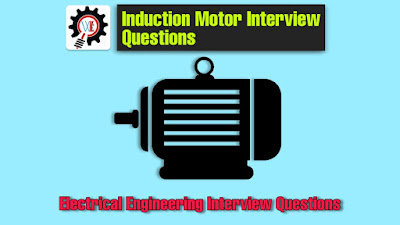Induction Motor Interview Questions with Answers | Part-1
Q.1 The frame of an induction motor is made of
(A) aluminium
(B) silicon steel
(C) closed grained cast iron
(D) stainless steel
(E) bronze
Answer: (C) closed grained cast iron
Q.2 The stator frame is an induction motor is used to
(A) hold the armature stampings in position
(B) ventilate the armature
(C) protect the whole machine
(D) provide return path for flux
Answer: (A) hold the armature stampings in position
Q.3 The stator core of a 3 phase induction motor is laminate in order to reduce the
(A) eddy current loss
(B) hysteresis loss
(C) both hysteresis and eddy current loss
(D) weight of the stator
(E) windage and friction losses
Answer: (A) eddy current loss
Q.4 An induction motor works with
(A) dc only
(B) ac only
(C) ac and dc both
(D) none of these
Answer: (B) ac only
Q.5 Which of the following statement associated with polyphase induction motor is/are correct?
(A) It can run one direction only
(B) It is simply a transformer whose magnetic circuit is separated by an air gap into two relatively movable portions, one carrying the primary and other the secondary winding.
(C) It needs more maintenance than that required by a dc shunt motor.
(D) It is more costly than a dc shunt motor of the same output rating.
Answer: (B) It is simply a transformer whose magnetic circuit is separated by an air gap into two relatively movable portions, one carrying the primary and other the secondary winding.
Q.6 The polyphase induction motors are, by a very considerable margin, the most widely used ac motors as
(A) these are cheaper in cost, simple and rugged in construction and require little maintenance.
(B) they are capable of operation under a wide range of power factors both leading and lagging.
(C) they have maximum efficiency and maximum starting torque.
(D) they have very good speed regulation.
Answer: (A) these are cheaper in cost, simple and rugged in construction and require little maintenance.
Q.7 Use of fractional pitch winding
(A) result in reduced leakage reactance.
(B) result in reduced axial length of the machine
(C) makes it stiffer
(D) all of the above
Answer: (D) all of the above
Q.8 If all the stator coils of an induction motor are connected for the same magnetic polarity, there will be formed an equal number of
(A) rotor poles with same polarity
(B) rotor poles with opposite polarity
(C) consequent poles with opposite polarity
(D) consequent poles with same polarity
Answers: (C) consequent poles with opposite polarity
Q.9 The induction motor shaft should be
(A) hollow
(B) stiff
(C) flexible
(D) any of these
Answer: (B) stiff
Q.10 The induction motor shaft is made of
(A) mild steel
(B) cast iron
(C) high speed steel
(D) stainless steel
(E) aluminium
Answer: (A) mild steel



Thanks alot whoever shared these brilliant question s
ReplyDeleteExcellent and decent post. I found this much informative. I'm impressed by the details that you have on this blog. Thank you for this post. XLPE Cable In India.
ReplyDelete60734
ReplyDeleteWow, this is good post, I have also seen this information here, electronics wholesalers uk
ReplyDelete